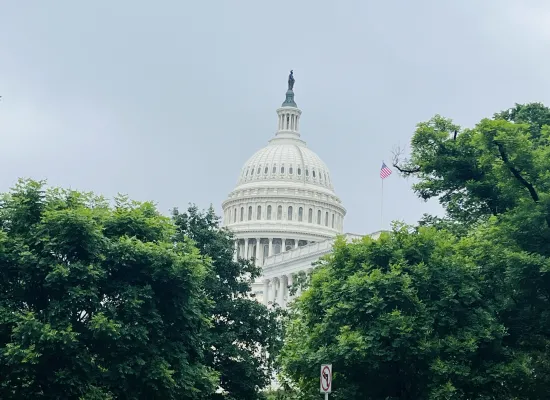
Summary of Health Provisions in the One Big, Beautiful Bill Act (H.R. 1)
Under the budget resolution adopted on April 10, 2025, the House Energy & Commerce Committee (E&C) was required to submit changes in laws under its jurisdiction to reduce the deficit by at least $880 billion over the fiscal years (FY) 2025-2034. On May 11, E&C Chair Guthrie released the committee’s legislative recommendations for budget reconciliation. The recommendations were approved by E&C on May 14 and were subsequently included in the One Big, Beautiful Bill Act (H.R. 1). On May 21, House Republican leadership introduced a manager’s amendment designed to address concerns raised by factions within the conference. The manager’s amendment is expected to increase cuts to government health programs, but note that all cost estimates reflect pre-amendment calculations. On the morning of May 22, the House of Representatives passed the One Big, Beautiful Bill Act 215-214-1, sending the budget reconciliation package to the Senate for further consideration.
The following is a summary of certain health provisions of H.R. 1 that may impact managed care pharmacy. Highlighted sections denote provisions that were changed by the manager’s amendment:
Medicaid and Individual Market Reforms:
The Congressional Budget Office (CBO) estimated that the E&C provisions of H.R. 1 would reduce the budget deficit by approximately $988 billion over 10 years, with over 80% of those savings ($804 billion) coming from the Health title. Medicaid is the largest target of cuts in the reconciliation package. The CBO estimated prior to the introduction of the manager’s amendment that federal Medicaid spending would be reduced by $625 billion. The committee achieved much of its reconciliation target by making it more difficult for adults to maintain health coverage under Medicaid and enroll in Affordable Care Act (ACA) marketplace plans. Preliminary estimates from the CBO found that the proposed changes to Medicaid and the marketplace would increase the uninsured population by 8.6 million people, including:
- Community Engagement Requirements: By December 31, 2026 (previously January 1, 2029), H.R. 1 would require able-bodied adults without dependents to demonstrate community engagement to qualify and remain eligible for Medicaid coverage. An individual can meet the community engagement requirements during a month by working, completing community service, participating in a work program, enrolling in an educational program, or a combination of these activities for at least 80 hours. The bill exempts several populations, including pregnant women, people under 19 or over 64, individuals who are considered medically frail, individuals who are already in compliance with work requirements for other welfare programs, and individuals with child or disabled dependents. It is difficult to estimate how many people would need to qualify for community engagement each month, especially given that the provision in H.R. 1 is slightly different from previous proposals that capped the engagement population at 55. An analysis from the Urban Institute found that roughly 13 million people ages 19-55 would need to comply. Another analysis from the Kaiser Family Foundation found that 92% of adults on Medicaid but would not be automatically exempted were either working, taking care of a dependent, ill or disabled, or attending school. The CBO estimates this proposal would reduce federal spending on Medicaid by $ 280 billion and is the largest saver in H.R. 1.
- Redetermination for Medicaid Expansion Population: According to the Kaiser Family Foundation, roughly 20 million adults receive Medicaid coverage under the ACA (expansion population). Current law requires that states redetermine whether an individual who is enrolled in the Medicaid program remains eligible every 12 months. Under the bill, states would be required to conduct eligibility redeterminations of the expansion population every 6 months starting on December 31, 2026 (previously, the implementation date was January 1, 2028). CBO projects that this provision, combined with another that would require more extensive address verification to prevent simultaneous enrollment in multiple states, would reduce spending by about $70 billion.
- Delay Medicaid and CHIP Eligibility Rule: The committee also proposed delaying a Biden administration rule intended to facilitate redeterminations and remove barriers to accessing Medicaid and Children’s Health Insurance Program (CHIP) coverage. The rule, which was finalized last year and has various implementation dates between 2025 and 2028, established timeliness requirements for redeterminations of eligibility, required states to take proactive steps to update enrollees’ contact information, removed barriers to children receiving CHIP coverage and transitioning between programs, and updated recordkeeping regulations. CBO estimated that delaying implementation of this rule, along with another rule that expanded access to Medicare savings programs, would reduce spending by about $165 billion.
- Codify Marketplace Affordability and Integrity Rule: H.R. 1 makes significant changes to the ACA exchanges. The bill finalizes a proposed rule that, among other things, institutes additional eligibility verification requirements, shortens the annual open enrollment period, reduces income-based special enrollment periods, and excludes Deferred Action for Childhood Arrivals recipients from marketplace coverage. The CBO estimated that codifying this rule would result in 1.8 million people falling off the exchanges, but would reduce federal spending by $101 billion.
- Marketplace Cost Sharing Reduction Payments: The manager’s amendment would appropriate funds for cost-sharing reduction payments (CSRs) for low-income beneficiaries in the individual market, starting in 2026. CSRs were created under the ACA to reimburse insurers for lowering out-of-pocket costs for eligible low-income individuals enrolled in silver marketplace plans. The first Trump administration abolished CSRs, which resulted in insurers raising premiums and increasing federal outlays for premium tax credits. While the CBO has not scored this provision, it may reduce federal spending by lowering premium tax credit payments. The bill prevents CSRs from reimbursing qualified health plans that provide coverage for abortion, except to save the life of the mother or to terminate a pregnancy that is a result of rape or incest. According to the Kaiser Family Foundation (KFF), 12 states require marketplace plans to cover abortion services and may come into conflict with this provision.
State Health Assistance Financing:
The reconciliation package also restricts states’ ability to finance their portion of medical assistance programs through provider taxes and state-directed payments. Under the Social Security Act, Medicaid provider taxes are defined as those for which at least 85% of the tax burden falls on health care items or services or entities that provide or pay for health care items or services. According to the KFF, every state except Alaska uses provider taxes to fund Medicaid base rates and supplemental payments, avoid benefit cuts, or expand benefits. The Centers for Medicare and Medicaid Services (CMS) authorized states to direct payments to providers under certain circumstances in their managed care contracts beginning in 2016. According to the Medicaid and CHIP Payment and Access Commissions (MACPAC), CMS approved 302 directed payment arrangements in 40 states between February 2023 and August 2024. Proponents argue that directed payments improve access to care by encouraging more providers to accept Medicaid patients, but critics are concerned about the lack of transparency and significant growth in payments, which total over $40 billion per year.
- H.R. 1 would freeze existing provider taxes at current levels and prohibit states from instituting new provider taxes. The CBO estimates that freezing existing provider taxes and preventing states from introducing new taxes would save the federal government $87 billion.
- Another provision would restrict how states structure their provider taxes to benefit specific providers and reduce federal spending by about $35 billion.
- The bill would prevent states from establishing directed payment rates that exceed the published Medicare rate, which would cut over $72 billion in federal spending. The manager’s amendment would allow non-expansion states to establish directed payment rates up to 110% of the Medicare rate.
Drug Pricing:
The committee used reconciliation to address priorities related to drug pricing and pharmacy benefit managers (PBMs). The legislative recommendations incorporate the ORPHAN Cures Act, which expands the orphan drug exclusion under the Medicare Drug Price Negotiation program. The ORPHAN Cures Act excludes any period in which a drug had an orphan designation from market approval calculations, used to determine when a drug may be selected for Medicare negotiation. The bill also excludes orphan drugs that are approved to treat more than one rare disease or condition from negotiation. The E&C recommendations include several components of the bipartisan PBM reform package that were left out of a continuing resolution last December:
Medicaid-PBM Contracts:
- Spread Pricing: The bill prohibits Medicaid programs from allowing their contracted PBMs to conduct spread pricing. PBMs that contract with states must implement a transparent pricing model that is based on a drug’s ingredient cost plus a professional dispensing fee not less than the price determined by the state.
- Transparency: PBMs must submit data to the state, and the US Department of Health and Human Services (HHS) upon request, detailing all costs and payments related to covered outpatient drugs and accompanying administrative services. Reports must conform to HHS requirements, including ingredient costs, dispensing and administrative fees, and post-sale and post-invoice fees, discounts, and related adjustments such as indirect and direct renumeration fees.
- Pharmacy Benefit Manager Definition: Finally, the bill establishes a new, standard definition for “Pharmacy benefit manager,” as any person or entity that acts as a price negotiator or group purchaser on behalf of a state, managed care entity, or other specified entity and carries out one or more of the following activities: 1) processing and payment of claims for prescription drugs, 2) performing drug utilization review, 3) processing drug prior authorization requests, 4) managing appeals or grievances related to prescription drug benefits, 5) contracting with pharmacies, 6) controlling the cost of covered outpatient drugs, or 7) the provision of services thereto.
Medicare Part D Plan Sponsor-PBM Contracts:
- Transparency: Beginning with the 2028 plan year, the bill requires PBMs to submit a report annually to HHS and every contracted Part D plan sponsor that contains information, including 1) cost and utilization data for each covered drug, 2) information related to the plan's spending at PBM-affiliated pharmacies, and 3) justifications for favorable formulary placement of brand or reference products over generic or biosimilar alternatives. PBMs are also required to identify and define benchmarks used in pricing guarantees or cost performance evaluations and allow their contracted plans to audit their performance at least once per year.
- De-Linking: Beginning with the 2028 plan year, the bill prohibits PBMs from receiving any compensation related to the dispensing of a prescription drug other than a bona fide service fee and incentive payments. A bona fide service fee means a fee that reflects the fair market value (defined by HHS rulemaking) of a service which is not based on the drug price; the amount of discounts, rebates, or other DIR; coverage or formulary placement; or the volume or value of any referrals or business generated. Incentive payments must be a flat dollar amount, consistent with fair market value, which is related to services performed by the PBM or an affiliate in connection with the utilization of covered Part D drugs. The bill gives the HHS Office of Inspector General authority to review all remuneration agreements between PBMs and other entities involved in the dispensing or utilization of covered drugs.
- Pharmacy Contract Standards: Under current law, Part D plan sponsors must permit any pharmacy willing to accept its network contract terms into the plan’s pharmacy network. Network contract terms must be “reasonable and relevant,” however plan sponsors are currently given discretion to determine what terms fit that standard. This bill removes that discretion from Part D plans and requires HHS to develop standard pharmacy contract terms.
Pharmacy Acquisition Cost Survey
- Expansion of Pharmacy Acquisition Cost Survey to Specialty and Mail-Order: Currently, the CMS conducts monthly surveys to estimate the acquisition cost of covered outpatient drugs for retail community pharmacies, which is then used to calculate the National Average Drug Acquisition Cost (NADAC). The NADAC is a frequently used benchmark for pharmacy reimbursements in state Medicaid programs. This bill would expand the survey to “applicable non-retail pharmacies,” which include mail-order and specialty pharmacies. Hospital, long-term care, and nursing home pharmacies, as well as clinics, non-profits, and government pharmacies, would be exempt from participating in the acquisition cost survey. States may not use applicable non-retail pharmacy acquisition costs as a benchmark for retail pharmacy reimbursement.
- Required Participation in Pharmacy Acquisition Cost Survey: The bill would require states to force all retail and applicable non-retail pharmacies that receive Medicaid reimbursement to participate in the monthly pharmacy acquisition cost survey. The bill gives HHS the authority to levy civil monetary penalties against any retail or applicable non-retail pharmacy that fails to respond to the survey or provides false information, up to $100,000 for each violation.
Curtailing Artificial Intelligence Regulations:
H.R. 1 would establish a 10-year moratorium on the enforcement of any state or local government regulation impacting artificial intelligence (AI) systems, AI models, or automated decision systems that enter interstate commerce. The bill contains a carve-out for regulations that treat AI systems the same as comparable non-AI systems. This could enable states to enforce rules that impact insurers’ use of AI systems in utilization management protocols, so long as the rules apply to all protocols.
Federal Student Loans:
H.R. 1 would make significant changes to federal student loan programs that may impact pharmacy students’ ability to afford tuition. According to the American Association of Colleges of Pharmacy and the National Center for Education Statistics, roughly 80% of student pharmacists utilize federal graduate student loans to fund their education. The bill would eliminate Grad PLUS loans for new borrowers starting in the 2026-2027 academic year and for existing borrowers starting in 2029-2030. Grad PLUS loans allow student borrowers to pay for both tuition and living expenses with more favorable terms than private loan options. The bill would also cap graduate education loans for student borrowers at $150,000.
Featured News & Resources
See Full CalendarAward Applications Open
AMCP eLearning Day: Nexus Encore
AMCP 2026 Registration Opens
Upcoming Events
AMCP offers a wide variety of educational opportunities, from events and webinars to online training.







